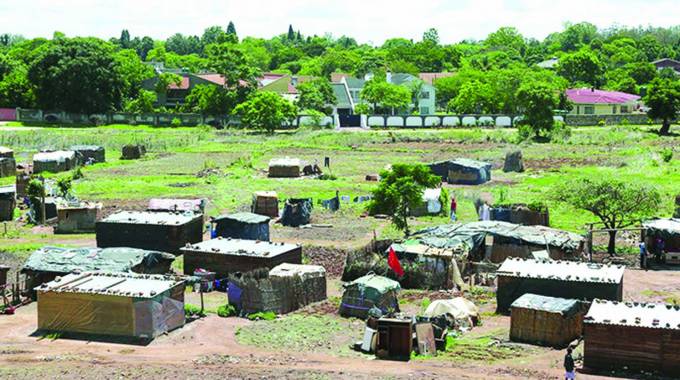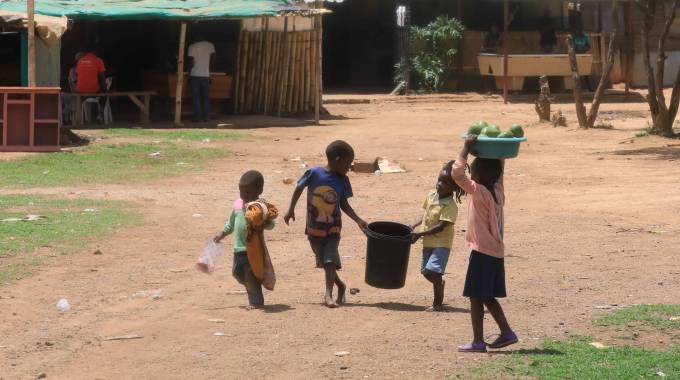
The Sunday Mail

Veronica Gwaze and Emmanuel Kafe
THE imposing Shawasha Hills is a suburb of contrasts.
On one side of the hills lie rows of plush mansions surrounded by pristine gardens. This is where the rich and famous reside.
On the foot of the hills, a slum made from scraps of tin sheets, wood and grass, sits on a two-hectare private property overlooking the grand and impressive villas.
The shacks appear to be stacked one on top of the other, the caving roofs so low that some of the residents, mostly families of four or more, have to crawl to get in and out.
The rainy season has exacerbated the situation, turning the huts into mud pools.
Groups of barefooted children play games in dirty puddles of stagnant water, increasing their chances of contracting water-borne diseases.
On the other side of the hills, their counterparts frolic in swimming pools, play house and enjoy jumping castles.
The situation in Shawasha is a microcosm of broader society, where communities existing side by side are, in fact, worlds apart. They may breathe the same air, but their lives are like day and night, starkly illustrating the gap between the rich and the poor.
The Shawasha slum is growing by the day on a private property called Tazorora plot, which is sandwiched by the magnificent mansions of Shawasha Hills and the affluent suburb of Glen Lorne.
So who owns the squatter camp?
According to locals, Tazorora plot was once a farm compound, some of whose ramshackle structures have existed for more than 19 years.
The two-hectare piece of land is registered under the now deceased Elijah Nguluve. After Nguluve’s death and that of his son, his daughter in-law Fortunate Baptista became the “landlord” or rather landlady.
She is the one allocating space to newcomers seeking accommodation. One only needs a cabin and $40 to get a place. Apart from that, she also takes care of a dozen more who cannot afford to pay rentals.
According to Baptista, the rental proceeds pay fees for her three children and the others she takes care of.
She said most residents on this squatter settlement are maids and gardeners who work for their affluent neighbours in Shawasha and Glen Lorne.
A few have formal jobs while others are handymen, mostly in the construction industry.

Children go to sell wares along the Harare-Mutoko Highway
Some squatters have been living there for years while others recently moved in.
“If you are out of work and do not have any money, where must you go? No one wants to help us. This is the only place for us,” one resident said.
But Tazorora is not the only slum near the Shawasha mansions, there are three more slums on the peripheries of the affluent suburb.
While most of the people living in these slums believe that poverty is normal, they are of the opinion that being surrounded by opulence is “strange”.
What they hate most is having outsiders prying into their lives. The slum dwellers hate cameras, lest their families discover the slum life they are leading.
The unspeakable happens here
When outsiders are around, the mood is politely chilly.
Most of the Tazorora residents were not born into poverty, some of them still believe they have a chance to claw their way out.
Most were carried by the tide of ill-fortune — lost jobs, failed marriages, run-ins with alcoholism and drug addiction — and ended up at the slum.
The slum is strategically positioned along the Harare-Mutoko Highway, a stone’s throw away from the tollgate. Vendors from this area say they enjoy brisk business at the tollgate.
But just like in any other shantytown, commercial sex work and crime thrives at Tazorora. Shebeens are a common feature and girls as young as 15 are already into sex work. Adult sex workers ply their trade in broad daylight.
Locals allege that when the sun goes down, top-of-the-range cars from the surrounding affluent suburbs are seen in the vicinity looking for sex workers and drugs.
“When there is congestion at tollgates, sex workers take advantage to market themselves. Some come for ‘quickies’,” said a woman in her twenties.
Another resident who spoke on condition of anonymity said some men from an adjacent leafy suburb have become regular clients for Tazorora’s sex workers.
“If you come here during weekends you will be surprised. We fear for our children because these men mostly prefer young girls. We have tried all we can to stop them but we have failed, we need help,” she said.
Another elderly man interjected, saying drug abuse has become rampant with youths in the area selling the drugs “on behalf of the rich people from the hills”.
Indeed, drug dealers have found this slum to be a haven. Even kachasu brewing is also a thriving business in the area.
Health time bomb
More than 100 families living at the squatter camp are sharing three toilets. They have one borehole, whose water was condemned after tests revealed that it is contaminated.
This is happening under the watch of Harare City Council, which is now delivering 5 000 litres of drinking water to the squatters every three days.
Baptista revealed that at some point, there was a typhoid outbreak that threatened almost everyone at the compound, until the Ministry of Health and Child Care intervened.
“The Ministry of Health had to come in because we were in a crisis. Fortunately, people got help in time and no one died,” she said.
However, Baptista is concerned about the health and well-being of the children at the squatter camp.
“Children risk contracting water-borne diseases because they just drink water anyhow. We don’t have a clinic nearby. The Government should help these people or give them somewhere to at least build their own homes,” she said.
Lawlessness
The mushrooming of squatter camps in Harare has sparked debate, with some saying the informal settlements are a result of lawlessness in the capital.
However, others are adamant that the high cost of urban accommodation is fuelling the situation.
Squatter camps, some of them even disguised as formal settlements, have been spouting in places like Hopley Farm, Mabvuku, Waterfalls, Chitungwiza and Borrowdale.
Experts say council is being passive on the matter.
Despite efforts by Government and other players in the housing sector, the housing waiting list is growing by the day. The national housing backlog currently stands at 1,3 million, with Harare alone requiring about half a million housing units.



